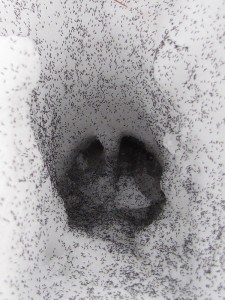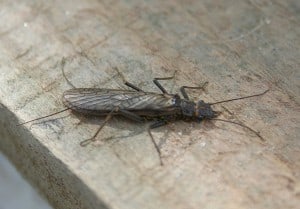Even people who don’t like winter will grudgingly admit “well, at least, there’s no bugs.” Guess again. Insects are indeed out and about in the winter woods. The good news, however, is that the species you’re most likely to encounter ‑ the minuscule snow flea ‑ has no interest in humans. Even better, like the return of cardinal and chickadee song, its presence is a sign that spring is fast approaching.
The snow flea (Hypogastrura nivicola) is not related to true fleas such as those your dog or cat might bring home
. It belongs to an ancient group of wingless invertebrates called Collembola, commonly known as springtails. Along with other species of springtails, snow fleas are among the most abundant insects known to science. Tens of thousands can be found in a square metre of soil. For most of the year, they live beneath the forest floor, dining on algae, leaf mould and other fungi. They are part of a group of organisms known as decomposers, which turn organic material into soil nutrients that are essential for plant growth. This, in turn, allows other animals to feed on the plants, which are the foundation of the food chain.
On mild, mid- to later winter days, snow fleas take advantage of the melted area around the base of trees to spread out on the surface of the snow. They will also make their way to surface via the deep tracks of deer. I often see them on or adjacent to the trails of the Kawartha Nordic Ski Club on Highway 28, near Haultain. They sometimes congregate in such numbers as to turn sections of the trail black. If you crouch down for a closer look, what initially appears like particles of soot or pepper will start jumping about in front of you, often completely disappearing from view.
Olympic jumpers
Only about 1 mm in length, snow fleas accomplish their incredible leaps thanks to a forked appendage called the furcula, which is attached to the tip of the abdomen. Most of the time, it is folded under the abdomen and held in place by a tiny latch, or tenaculum. When the snow flea decides its time to move, it arches its body, thereby releasing the latch. Loaded with elastic energy, the furcula swings down and sends the tiny insect catapulting skyward. It can, in fact, hurdle itself an amazing 13 centimetres, which represents 65 times its body length. In human terms, that’s like being able to jump the length of a football field!
How do they survive?
Insects are exothermic, which means that their body temperature and activity level depend on the air temperature. The cold usually renders them inactive. The snow flea, however, has overcome these limits and thrives in sub-zero environments. First of all, its black coloration allows efficient absorption of heat from the sun. The microclimate in the sheltered spaces between the ice crystals is also substantially warmer than the surrounding air. In addition, four hundred million years of evolution have allowed snow fleas to produce a kind of natural anti-freeze. Researchers at Queen’s University have actually synthesised this protein, which is unlike any other previously known to science. They hope that similar proteins may be used for storing transplant organs. By preventing the formation of ice crystals in tissues, organs could be stored at lower temperatures and therefore remain available for transplants over longer periods.
Mysteries remain
What are snow fleas doing out on the snow, when most self‑respecting insects are overwintering as eggs, larvae, pupa or inactive adults? It was once thought that they emerged to feed on microscopic algae, bacteria and fungi on the snow’s surface. This, however, has been disproved. A new hypothesis is that by late winter they have reproduced to a point where space is at a premium. The overcrowding means that some have to escape to the surface, where they simply wander around aimlessly until colder temperatures force them back under the snow and into the soil.
There is also some doubt whether snow fleas are even insects. Their primitive anatomy has much in common with hexapods, an even more ancient group of invertebrates from which insects are believed to have evolved. Like countless other areas of science, so much about snow fleas remains shrouded in mystery.
Stoneflies
Another insect to watch for at this time of year is the winter stonefly. On mild, sunny days, adult stoneflies can be seen crawling over the snow in areas close to running water. They are weak fliers and do not stray far from the water’s edge. Like gray squirrels, skunks and great horned owls, stoneflies seek out partners early in the season to beat the spring mating rush. After mating, the female returns to the frigid water of the stream to lay her eggs.
The stonefly’s life cycle is quite unusual. After the eggs hatch in the spring, the larvae bury themselves in the mud of the streambed, where they lie dormant all summer. In this way, they avoid dangers such as fish predation, low summer oxygen levels and fluctuating water flows. They emerge from the mud in late November, grow quickly into the adult stage and are ready to mate by mid‑winter.
One species commonly seen along Jackson Creek in Peterborough is the small winter stonefly (Capnis genus). I often find them on the snow adjacent to the creek. This stonefly is black, measures about eight millimetres in length, and folds its wings flat over its back. It has two prominent tails (cerci). Since stoneflies require clean, moving water to survive, their presence is usually an indicator of good water quality. In some jurisdictions, winter stonefly numbers are closely monitored to gauge the health of rivers and streams.
There are a couple of other insects to watch for if you’re out in the woods this winter. Snow scorpionflies (Boreus brumalis), dark-bodied insects about seven millimetres in length, are active on mild winter days. Look for them on or near the moss in which they develop. Males have only rudimentary wings, while females have no wings at all. The latter have a prominent ovipositor, however, which is used for laying eggs.
Near streams, keep an eye open for the wingless winter crane fly (Chionea genus). At first, you may dismiss it as a lost spider, but a quick count of the legs ‑ six instead of eight ‑ will prove that it is indeed an insect. Its dark‑brown colouration makes the winter crane fly easy to see against the snow. You may be familiar with the crane flies we see in summer. They look like giant mosquitoes with a wingspan of about three centimetres and extremely long legs. The winter crane fly has evolved as a wingless, smaller‑sized version of its summer cousin with special adaptations to winter life.
To the curious and mindful observer, there is far more going on in the winter woods than first meets the eye. As with so much in nature, it’s mostly a matter of being patient and paying attention.

